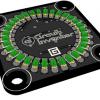Oops.Made a terrible mistake going over "Getting Started with the Internet of Things"
I assume you meant the potentiometer?A nice puff of smoke (from the meter, not the board) and a horrible smell..no mosquito's tonight.
So the wiper must have been set to short circuit the 5V to the Gnd.
Time to do some fault finding....
If we assume you were powering the board from USB, then you may have damaged something between the 5V pin and the USB 5V input. Or, you may have damaged the USB circuitry in your PC.
PC
First I would suggest trying another USB peripheral (e.g. a mouse) on the same USB port you had the Netduino plugged into. Does the mouse light up and run normally?
- If so, the PC is OK, Netduino must be damaged.
- If not, the protection circuit in the PC may have blown. Try a different USB port.
Netduino
Looking at the circuit diagram, there is a fuse and a transistor between the USB 5V input and the 5V output pin. The transistor is used to allow the USB to power the board when there is not a power input on the Vin / barrel inputs. There is a also a PCB track linking everything up, this could also act as a fuse - lets hope that it didn't.
I think it would be worth you trying to power the board using one of the following methods:
- apply 7 to 12V DC on the barrel connector
- apply 7 to 12V DC on the Vin pin
- apply a regulated 5V DC on the 5V pin (this pin can be used as an input)
If this works, I think we can assume your board has blown the fuse or the transistor. But, is still usable. We could probably hack the board to route power from the USB input to the 5V line if you really wanted to.
If it does not work, a track may have burnt out, or something else I missed has happened.
Hope this helps identify what is actually wrong.
Let us know what you find - Paul
- Basset likes this



 Find content
Find content Male
Male














